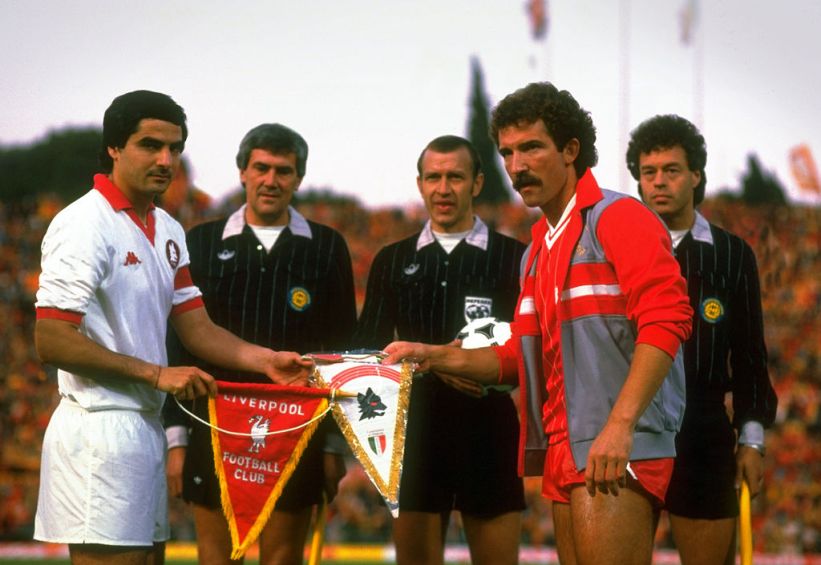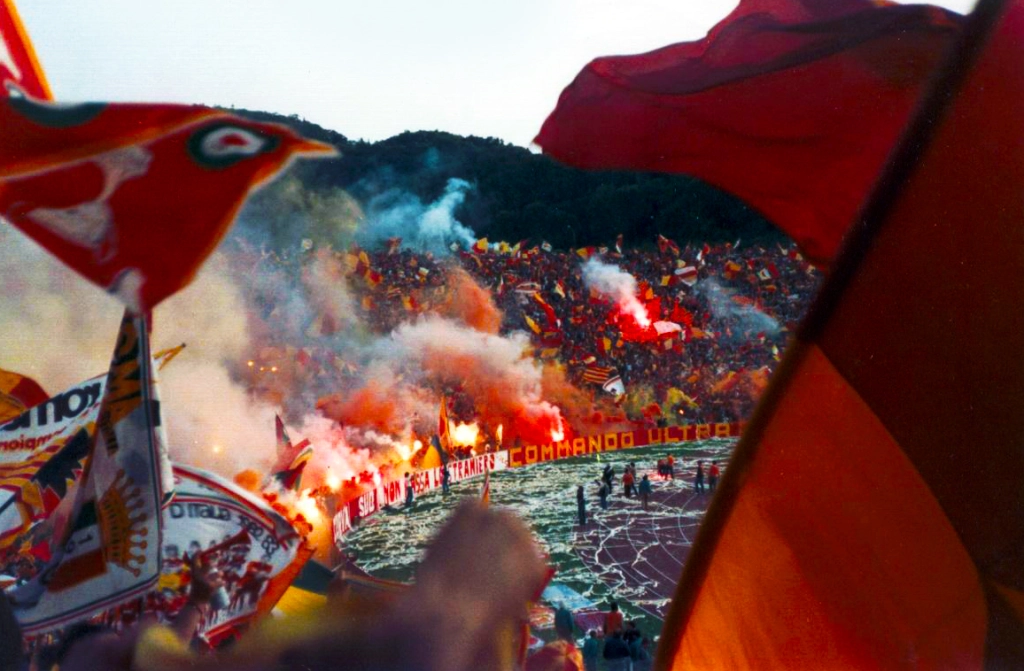It didn’t matter how you got there, just as long as you got there: Squeezed into to the back of barely roadworthy Ford Granada with another six bodies, or in the relative comfort of the student-friendly Transalpino rail service, everyone had their preferred mode of travel, but as the saying goes – all roads lead to Rome.
It was 1984, Liverpool were about to face Roma in their own backyard with the European Cup at stake. On Merseyside, preparations were underway. For many, the priority was to dress right for the occasion (as well as beating the Italians on the pitch, the Liverpool fans were keen to outdo them in the fashion stakes) so a trip to the Wades Smith sports shop on Slater Street to pick up a new set of trabs (trainers to you and me) was in order. Adidas of course.
The exodus finally began about three days before kick-off. From the old V streets in the shadows of Anfield Stadium to all four corners of the globe, local and exiled Scousers alike were folding banners, packing bags and loading bevvies into boots of cars, as complex journeys via air, land and sea got underway. This was not an unusual event. In fact, it had become a regular ritual, such was Liverpool FC’s prowess in European Football. For a 10-year period between 1975 and 1985, Liverpool fans took over the plazas of countless European cities and decorated them in the colours of their team. This was the era of Scouse freedom of movement.
In 1976, it was Bruges; in 1977, it was Rome; in 1978, it was Hamburg and Wembley, this list goes on. But these trips were about more than just away games, they were about a subculture that had been born out of a city in decline. These trips were a chance to escape the bleakness of everyday life. A chance to wear your best clobber, sing, drink and generally get up to mischief – the tomfoolery only pausing for the odd football match.
Admittedly, the welcome was not always a warm one. By the early 80s, British fans had gained a reputation for hooliganism and the Italians themselves were known for their volatile behaviour. Just a few months earlier, Spurs’ fans had been condemned for causing trouble in Brussels, while Dundee United’s supporters and players had been targeted from the moment they arrived in Rome for the second leg of the European Cup semi-final a month or so before. So, despite Liverpool’s attempts to promote a cordial relationship by sending a team of peace envoys prior to the game, many in the Italian capital were bracing themselves for an invasion of British “Barbarians.”
Roma fans had their own agenda. They were about to play a European Cup final on home soil and there was no way they were going to lose. So, with no travel arrangements to make, they set about planning how they were going to celebrate on the streets of the Eternal City. Parties were organised, banners were made and days off work were booked. This celebration was going to make the 1983 Scudetto party look tame.
Some Ultra groups were also preparing for the arrival of the Liverpool fans. Weapons were stashed in strategic places, and battle plans were laid out in the event they should come under attack. But, after public pleas from both clubs’ hierarchies for peace, there was a feeling that as long as the visitors didn’t cause any trouble and took their upcoming defeat in good spirits, there would be no drama. In fact, in the hours before the match, rivals fans could be seen sharing drinks and having kickabouts in the plazas and parks around the city. But then the unthinkable happened: Liverpool won.

Captains Agostino Di Bartolomei and Graeme Souness exchanging pennants.
It wasn’t a classic match but it was a hard fought one. With the scores level after 120 minutes, it took a penalty shootout (featuring Bruce Grobbelaar’s famous wobbly legs) to separate the teams, Liverpool holding aloft their fourth European Cup. For many Italians, this was a looting, a smash and grab, a theft from their doorstep and it could not go unpunished.
With the party arrangements shelved, the battle plans were pulled from the back burner – the mood turning sourer by the minute. Liverpool fans had grown used to running the gauntlet after European away games, but this was something else. The Roma fans were everywhere: on foot, in cars and on scooters, carrying out coordinated ambushes on those who had stolen their dream.
For some visiting fans, it seemed there was nowhere to hide – in the car parks, the underpasses and amongst the statues outside the stadium, they were spotted and targeted for attack. Some were pelted with stones and bottles, others were beaten with sticks and some were stabbed or slashed with stiletto knives – the weapon of choice back then. The short walk from the turnstiles to the coaches was a battlefield. Such was the carnage many paparazzi sped off to the local hospital to get better shots of the victims rather than risk getting hit by missiles.
Meanwhile, the police seemed to have no control over the situation, and turned a blind eye to much of the violence. Occasionally, they would flag down a passing vehicle and bundle in a bloody victim, instructing the driver to ferry them to the hospital, or issue a beating of their own if a foreigner was seen to be acting belligerently. When things got really ugly, they tried to break up the clashes with tear gas. Local gangs responded by relocating to the city centre where they could pick off rival fans making their way back to hotels.
Some Liverpool fans found sanctuary in Laziali bars, while others were relieved to board the late-night-special trains that took them north to Turin, where connections to France were waiting. Upon arrival in the Piedmont capital, they were greeted by a hastily painted mural that read “Grazie Liverpool” and many station staff were adorned in Liverpool hats and scarves – parting gifts from the hundreds of fans that had passed through that night. There were smiles, handshakes and warm embraces – a brief moment of solidarity that would be lost forever when Juventus faced the Reds in the final of the same competition a year later.
Despite more than a dozen stabbings that night, those in a position of authority seemed uninterested in dealing with what happened, such was the contempt towards the patrons of the game during that era. Events within the stadium had passed without incident and that’s all that mattered. Advice to implement sensible measures such as keeping away fans back after the game and parking visiting coaches in secured areas was ignored, and it wasn’t until later, when multiple lives were lost, that the safety of those attending football matches even began to be taken seriously.

